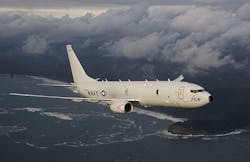Is the Navy's P-8A Poseidon jet evolving into a multi-sensor strategic reconnaissance platform?
The Navy awarded a $60.8 million contract to Boeing last week for several enhancements to the P-8A aircraft command, control, communications, computers, intelligence, surveillance, and reconnaissance (C4ISR) capabilities. Boeing makes the Poseidon.
These enhancements would make the P-8A far more versatile than simply long-range ocean patrol and anti-submarine warfare (ASW). Among the upgrades under this contract is Minotaur, which most likely involves an integrated sensors, computing, and communications system to enable P-8A aircrews to gather and process surveillance information for transmission to shore and surface operators.
It wouldn't be surprising to see the P-8A evolve beyond its original maritime patrol and ASW roles. The Navy, in fact, refers to the plane as a multi-mission aircraft, not just an ocean-surveillance plane.
Related: Navy boosting C4ISR, multi-sensor intelligence capabilities of P-8A Poseidon ASW aircraft
From its introduction three years ago, the Navy P-8A already has an impressive set of military capabilities.
The Poseidon has the gyro-stabilized L-3 Wescam MX-20HD digital electro-optical and infrared (EO/IR) multi-spectral sensor turrets with infrared, CCDTV, image intensifier, laser rangefinder, and laser illuminator sensors.
The aircraft also has the upgraded Raytheon APS-137D(V)5 maritime surveillance radar and signals intelligence (SIGINT) system, which provides synthetic aperture radar (SAR) for imaging stationary ships and small vessels, coastal and overland surveillance, and high-resolution imaging synthetic aperture radar (ISAR) for imaging surfaced submarines and fast surface vessels operating in coastal waters.
For its ASW role, the P-8A has the CAE Inc. advanced integrated magnetic anomaly detection (MAD) system, and can drop versions of the MK 54 torpedo. For the future BAE Systems is developing the High Altitude ASW (HAASW) Unmanned Targeting Air System (UTAS) for the P-8A. The HAASW UTAS will involve an unmanned aerial vehicle (UAV) deployed from the P-8A equipped with MAD systems and algorithms to detect and pinpoint submerged enemy submarines.
As if the P-8A's surveillance and ASW capabilities were not already enough, last week's contract calls for Boeing to add not only the Minotaur system, but also Multi-Static Active Coherent (MAC) enhancements; wide-band satellite communications (SATCOM); a new computing and security architecture; automated digital network system common data link upgrades; anti-surface warfare signals intelligence (SIGINT); combat system architecture improvements; and communication capability upgrades.
MAC is an ASW system to detect, locate, and identify enemy submarines using sonar emitters and receivers in separate locations on separate platforms, such as submarines, surface ships, ASW sonobuoys, and helicopter dipping sonar. It brings coherent acoustic source technology and improved signal processing to the P-8A.
With advanced systems like these, the Navy Poseidon multi-mission aircraft has the potential to replace or complement the Navy's EP-3 signals reconnaissance aircraft -- a SIGINT version of the Navy's four-engine turboprop P-3C maritime patrol aircraft, and perhaps even the U.S. Air Force RC-135 Rivet Joint reconnaissance aircraft.
Upgraded P-8A aircraft also have the potential to fill the anticipated role of the Navy's now-cancelled EP-X program, which had been intended as a replacement for the EP-3 for maritime signals intelligence.
The Air Force RC-135 Rivet Joint is based on the ageing four-engine Boeing 707 airframe and used for theater- and national-level intelligence gathering and real-time analysis and dissemination.
Military electronics systems integrators may be working on modular payloads that could be added to and removed quickly from the P-8A to tailor the aircraft for specific missions.
The Boeing 737 airframe, on which the P-8A Poseidon is based, has been one of the most versatile and widely used narrow-body large jets since its introduction in the 1960s. Now it looks like the P-8A will be true to its heritage as one of the Navy's most versatile long-range maritime surveillance, ASW, and C4ISR aircraft.
Learn more: search the Aerospace & Defense Buyer's Guide for companies, new products, press releases, and videos
